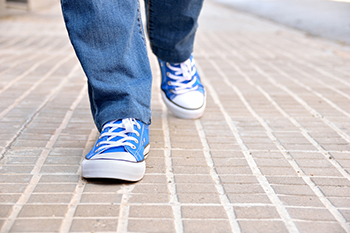A normal stride, or way of walking, includes five distinct phases: Heel-Strike, Support, Toe-Off, Leg Lift, and Swing. In the Heel-Strike phase, the leading foot makes contact with the ground heel first. The rest of the foot then follows suit in the Support phase, contacting the ground while forcing pass through the leg. In the Toe-Off phase, the foot prepares to leave the ground starting with the heel and ending with the toes. Once the foot is off the ground, the lower leg works to raise it during this Leg Lift phase to prepare for the final phase: the Swing phase. In this phase, the raised leg moves in a forward motion, propelling the body forward. There are various foot conditions that can alter this normal pattern of walking, as well as neurological conditions, skeletal deformities, medical conditions, obesity, arthritis, sensory or motor deficiencies, peripheral arterial disease, and more. If you believe your gait is being compromised in some way, make an appointment with a podiatrist who can perform a biomechanical gait analysis and discuss ways to help correct any abnormalities.
If you have any concerns about your feet, contact Charles Perry, DPM from Ohio. Our doctor can provide the care you need to keep you pain-free and on your feet.
Biomechanics in Podiatry
Podiatric biomechanics is a particular sector of specialty podiatry with licensed practitioners who are trained to diagnose and treat conditions affecting the foot, ankle and lower leg. Biomechanics deals with the forces that act against the body, causing an interference with the biological structures. It focuses on the movement of the ankle, the foot and the forces that interact with them.
A History of Biomechanics
- Biomechanics dates back to the BC era in Egypt where evidence of professional foot care has been recorded.
- In 1974, biomechanics gained a higher profile from the studies of Merton Root, who claimed that by changing or controlling the forces between the ankle and the foot, corrections or conditions could be implemented to gain strength and coordination in the area.
Modern technological improvements are based on past theories and therapeutic processes that provide a better understanding of podiatric concepts for biomechanics. Computers can provide accurate information about the forces and patterns of the feet and lower legs.
Understanding biomechanics of the feet can help improve and eliminate pain, stopping further stress to the foot.
If you have any questions please feel free to contact our offices located in Cambridge and Zanesville, OH . We offer the newest diagnostic and treatment technologies for all your foot and ankle needs.

